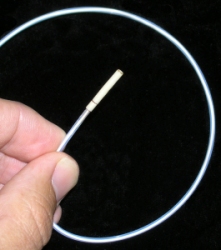Nov 5 2009
Nearly 4 million people nationwide suffer from cardiac arrhythmias each year, according to the 2006 U.S. Cardiac Rhythm Management Market report by Frost and Sullivan. About 2.5 million of these cases cannot be treated or controlled through medication alone. Since pharmacological therapies have limited effectiveness, radiofrequency (RF) catheter ablation has emerged as the prominent approach for treating a broad range of arrhythmias. However, during the procedure physicians have no direct visualization of intra-cardiac structures, nor do they have a means to measure successful lesions.
 Optical Coherence Tomography - Forward Imaging Catheter Utilized in the Treatment of Cardiac Arrhythmias
Optical Coherence Tomography - Forward Imaging Catheter Utilized in the Treatment of Cardiac Arrhythmias
Recognizing this problem, researchers at Case Western Reserve University began a research program in 2008 to build an imaging catheter that would allow surgeons to monitor treatment and visualize intra-cardiac structures. The researchers selected Avo Photonics, Inc., of Horsham, PA, for a Phase 1 design contract. The contract was awarded in September 2008. Avo’s rapid design effort provided a pathway for a subsequent October 2008 award for the development of prototype opto-mechanical systems. At the contract conclusion, Avo delivered eight forward imaging catheters to the university.
The forward imaging catheters (FIC) built by Avo will be used as monitors during RF cardiac arrhythmia therapy. These OCT catheters will lead to imaging techniques that will improve the insertion and accuracy of RF catheters, thus leading to better patient results and an expansion of approved FDA procedures for cardiac arrhythmia therapy.
Case Western Reserve University’s lead investigator on the project is Dr. Andrew Rollins, associate professor in the Department of Biomedical Engineering. Christine Fleming, a graduate research assistant under the advisement of Rollins, was instrumental in the design and development.
As a specialized opto-electronic engineering and manufacturing company, Avo provided critical resources and experience to the program. The Avo team was led by Program Manager Todd Rixman and Senior Optical Engineer Dr. David Demmer. “Our extensive experience in fiber optic and medical products blended to create reliable and elegant optical assemblies. We are pleased to be able to offer these service to Case Western Reserve”, stated Rixman.
In May of 2009, Case Western Reserve imaged heart tissue through the Avo produced catheters, thus confirming Avo’s design and manufacturing expertise. Both Dr. Rollins and Ms. Fleming expressed their gratitude to Avo Photonics. “Avo provided excellent resources as the development process proceeded” commented Dr. Rollins. “Avo’s attention to detail and resourcefulness allowed us to move quite rapidly from concept to design to prototyping. We are looking forward to continuing with the development efforts and providing the medical community with this and other enhanced tools” continued Dr. Rollins.
This work was funded by under the Coulter-Case Translational Research Partnership.